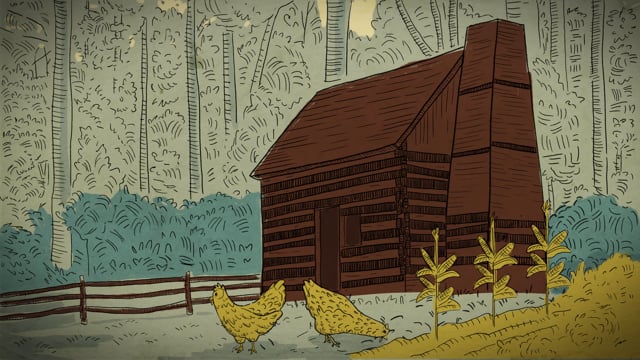1800
The Association Takes Control of Mount Vernon
The MVLA takes control of the property. Founder Ann Pamela Cunningham insists on preserving the estate as Washington knew it, including the outbuildings where enslaved people worked and lived.
Let no irreverent hand change the home of Washington...
Ann Pamela Cunningham, 1874
Late 19th Century
The MVLA hires formerly enslaved people and their descendants to work on the estate as paid laborers, including Thomas Bushrod and Tom Quander. Some provide valuable information to assist in the furnishing of the Mansion.
1900
An Early Memorial
The MVLA places a memorial stone at the site of the slave cemetery near Washington’s tomb. Annie Burr Jennings, Vice Regent for Connecticut, pays for the marker. While the reference to “faithful colored servants” embodies a nostalgic view of slavery, the marker represented an early effort to acknowledge the lives of those who labored on the estate.
Greenhouse Slave Quarter Reconstruction
The MVLA reconstructs the greenhouse slave quarter, which had been destroyed by fire in the 19th century. In 1962, one interior bunkroom is refurnished and opened to the public, the first time visitors to Mount Vernon can learn about the private lives of enslaved people.
Slave Memorial by Howard University
After the 1929 marker is found to be overgrown and nearly invisible, local activists lead efforts to place a new memorial at the slave cemetery site. Architecture students from Howard University design the monument. In 1990, the service organization Black Women United for Action begins the tradition of an annual wreath-laying ceremony at the memorial.
"Slavery in the Age of Washington" Conference
Mount Vernon sponsors a two-day conference entitled “Slavery in the Age of Washington.” Papers from the conference are published in 2001.
"Slave Life" Tour
Mount Vernon begins offering a “Slave Life” tour focused on the estate’s enslaved people. One of the staff members leading the tour was Gladys Quander Tancil, a relative of Nancy Quander, an enslaved woman freed by Washington’s will. Tancil was the first African American historical interpreter at Mount Vernon.
2000
Replica Slave Cabin
Mount Vernon opens a replica slave cabin at the Pioneer Farm site, based on an early 20th-century photograph. This replica structure shows the conditions under which much of Mount Vernon's enslaved laborers lived.
Greenhouse Slave Quarter Refurnishing
The greenhouse slave quarter is refurnished based on ongoing research and an additional bunkroom opens to visitors.
Expanded Digital Content
Mount Vernon launches a new website, significantly growing its digital presence. As part of this effort, new videos are produced to highlight true stories of the enslaved at Mount Vernon.
Archaeological Research at the Cemetery
Mount Vernon’s archaeology team begins an ongoing survey of the slave cemetery site. The goal is to determine the number and arrangement of graves in order to improve understanding of the burial ground. By 2022, archaeologists identify 86 graves of the enslaved men, women, and children who lived and worked on the property prior to 1860. No human remains will be disturbed.
Database of Enslaved People
Mount Vernon establishes a database compiling all references to enslaved people at Mount Vernon and other Washington properties. More than 900 individuals have been identified, with more than 500 at Mount Vernon.
Oral Histories with Descendants
In conjunction with the exhibition Lives Bound Together, Mount Vernon conducts interviews with descendants of enslaved people in order to record their family stories.
Region and Nation in American Histories of Race and Slavery Conference
The Omohundro Institute of Early American History & Culture and The Fred W. Smith National Library for the Study of George Washington sponsored a major conference on the topic of slavery and race. The event drew more than 100 scholars from across the country to the estate for three days of papers, conversation, and learning.
Participants included senior scholars, like Lorena Walsh and Ira Berlin, whose decades of work has shed light on slavery, plantation management, and the history of the slave trade. Attendees also included museum educators and others involved in public history and rising scholars.
Enslaved People of Mount Vernon Tour
As a newer incarnation of the “Slave Life” tour, Mount Vernon begins offering the “Enslaved People of Mount Vernon” tour, which focuses on incorporating more individual stories of those enslaved at Mount Vernon. The information offered on this tour is the result of 30 years of study conducted by Mount Vernon specifically into the lives of enslaved people. In addition to offering this specialized tour, Mount Vernon also begins a more deliberate effort to integrate the stories of the enslaved into its general interpretation.
Lives Bound Together Exhibition
A new exhibition opened at the Donald W. Reynolds Museum at Mount Vernon on October 1, 2016. Lives Bound Together: Slavery at George Washington’s Mount Vernon explores the personal stories of the people enslaved at Mount Vernon while providing insight into George Washington’s evolving opposition to slavery.
Exhibition Overview
The League of Descendants Founded
The League of Descendants of the Enslaved at Mount Vernon is established with the mission “to honor and share the history of the enslaved, free Blacks, and indigenous peoples at Mount Vernon.”
Union Farm
The MVLA enters into an agreement with the Fairfax County Park Authority allowing Mount Vernon archaeologists to perform research at the former site of an overseer’s residence and quarter for enslaved persons on Washington’s Union Farm. In 1799, the year of Washington’s death, there were 76 enslaved men, women, and children living at Union Farm.























